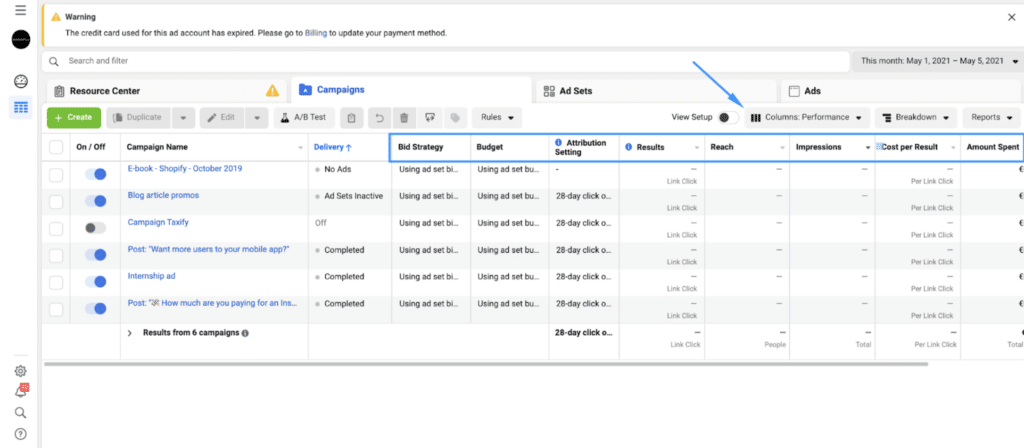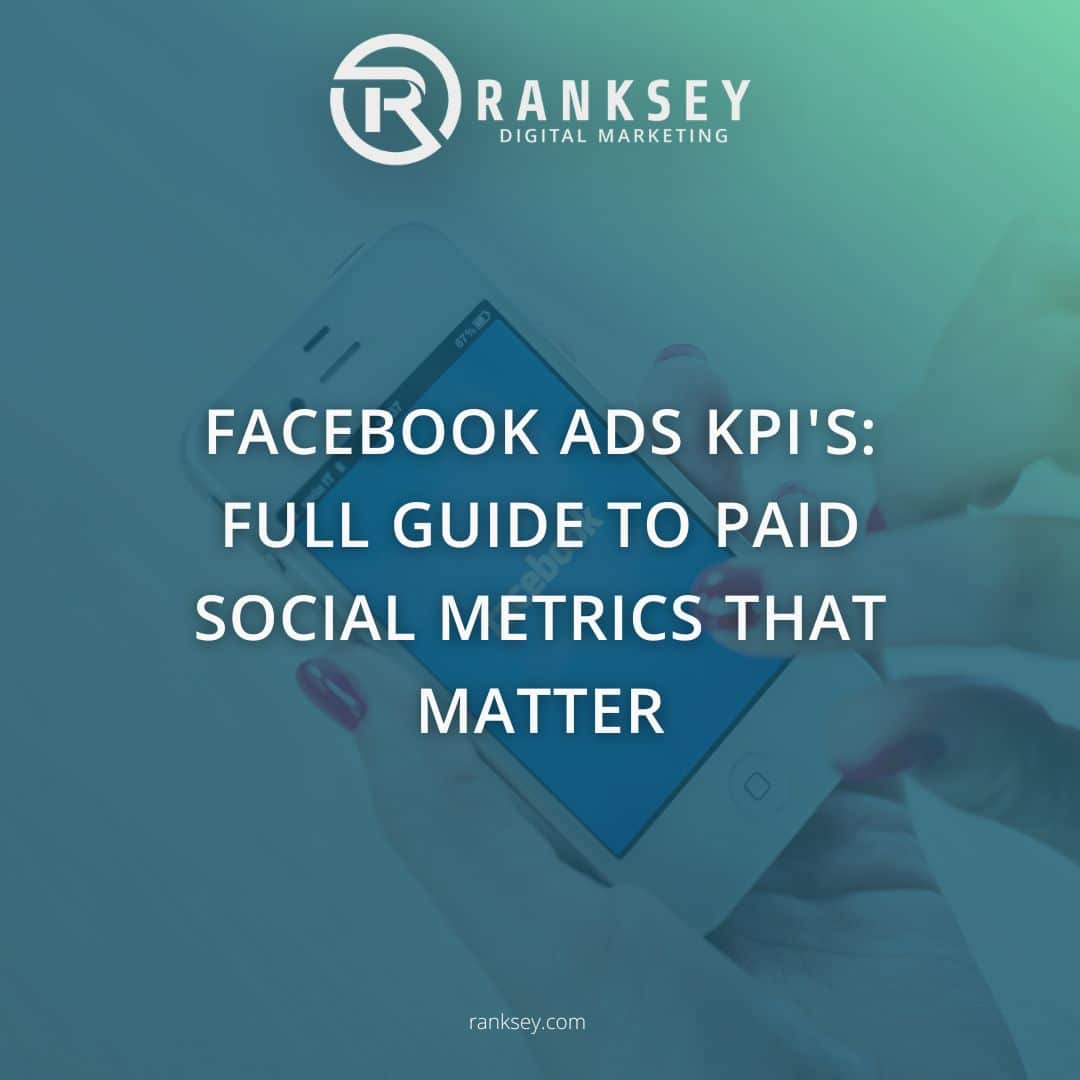Facebook offers a variety of Key Performance Indicator (KPIs) metrics geared explicitly towards enabling you to monitor and report on your social media advertising efforts. Whether your business is focusing on lead generation or E-Commerce sales, these metrics are important to evaluate regularly. By tracking Facebook Ads KPIs, you can make data-driven decisions to optimize your business’s advertising for better results and long-term growth.
What is a Facebook Ads KPI?
Facebook Ads KPIs are performance metrics that can be used to track the performance and effectiveness of your Facebook Ads. Paid social KPIs differ from paid search advertising because you are charged based on when your audience views your ad rather than when they click on it. Facebook also utilizes robust audience targeting options that allow you to reach your target audience based on their likes and interests. You can adjust what KPIs show up on your dashboard by selecting the Columns button.

Image Source: Karola Karlson
The Most Common Facebook ADs KPIs
Facebook’s focus on user engagement sets Facebook Ads KPIs apart from those of other paid advertising platforms. You can track many engagement-focused Facebook Ad KPIs, including metrics such as Reach, Unique Link Clicks, and Ad Relevancy. You can also track standard KPIs like Cost-per-Click, Click-Through Rate, Conversions, and Cost Per Result. Each of these metrics should be monitored based on your specific campaign objectives in alignment with your marketing goals. Below, we’ll break down the most common Facebook Ads KPIs that you’ll see when running ads on their ad platform.
Impressions
Impressions measure the number of times an ad is displayed on your audience’s social media feed. Unlike paid search advertising, you are charged every time your Facebook ad is viewed by your audience whether the user clicks on it or not. It’s worth noting that Facebook uses an auction system where ads compete for impressions based on bid and performance, so what you pay per impression will vary.
Reach
Reach helps you understand how many people you’re reaching with your ads within your target audience. Unlike Impressions, which measure the total number of times an ad was seen by your audience, reach tracks the total number of unique users who have viewed your ad(s).
Clicks
Clicks represent the total number of times a unique link has been clicked in a Facebook ad. However, it’s worth noting that if the user clicks the same link multiple times, it will be counted as multiple link clicks. Links can be displayed in the Primary Text field of the ads as well as the URL section of the ad. By monitoring link clicks, you can track how many users actually visit your website from your ads.
Cost Per Click
Cost per Click (CPC) measures the amount you pay for each click on your Facebook ads. CPC is calculated by dividing the total cost of the ad-spend by the number of clicks that were generated. You can choose to optimize and increase the total number of clicks by using “website traffic” as your campaign objective.
Click-Through Rate
Click-Through Rate (CTR) measures the ratio of users who click on a Facebook ad. CTR is calculated by dividing the total number of clicks on an ad by the total number of impressions received, then multiplying the result by 100 to get a total percentage. You can measure how well your ads resonate with your target audience by monitoring the CTR metric.
Ad Frequency
Ad Frequency refers to the number of times that the same user on their feed views a social media ad. Users may become bored or disengaged when they see the same ad multiple times, resulting in a lower engagement rate and ad fatigue. It is important to avoid ad fatigue by lowering the frequency of an ad; you can maintain user interest and ensure that their ads continue to generate engagement and conversions.
Cost Per Result
Cost per Result (CPR), sometimes called Cost per Acquisition (CPA), is a critical paid social KPI for any conversion event. CPR is calculated by dividing the total cost of a social media advertising campaign by the number of conversion actions users take. For lead generation this includes such as filling out a contact form, downloading a guide, or subscribing to a newsletter. However, the metric could also be calculated for the number of purchases made from the ad. This metric helps you understand the cost-effectiveness of your advertising efforts and the value of each conversion action.
Conversions
Conversions refer to the number of times a specific action is taken on your website. Monitoring conversions is essential for businesses looking to achieve their marketing goals and maximize their ROI. This action can be a lead form being filled out or a purchase being made on your website. Conversions can account for both micro and macro actions, as long as they align with your business’s social media advertising goals. You can identify which campaigns generate the most conversions and adjust your strategies to increase your overall conversion output.
Conversion Rate
Conversion Rate measures the percentage of users who complete a specific conversion action. The conversion rate is calculated by dividing the total number of conversions by the total number of clicks generated by your ads, then multiplying the result by 100 to get the percentage. By monitoring conversion rate, you can optimize your ad copy and landing page experience to better resonate with your target audience and increase the number of conversions you receive from your ads.
Ad Relevancy
Ad Relevancy measures the impact an ad has on its target audience based on whether the ad is perceived positively or negatively. This metric is determined by Facebook’s algorithm, which considers various factors such as engagement rates, feedback, and relevancy scores to assess the overall impact of ads. The ad relevancy score ranges from 1 to 10.
ROAS
One of the most important Facebook Ads KPIs for your E-Commerce business is Return on Ad Spend (ROAS). ROAS is calculated by measuring the revenue generated per dollar spent on advertising. This metric is displayed as a ratio and clearly shows how much revenue was generated from your ad spend. Due to the iOS 14.1 update, Facebook can’t attribute every purchase back to your ads so be sure to track your purchases using a third-party website analytics tool.
What Facebook Ads KPIs Should You Be Tracking?
Many Facebook Ad KPIs may appear as vanity metrics if they don’t properly align with your campaign goals. You need to track critical Facebook Ads KPIs such as Reach, Return on Ad Spend (ROAS), Conversions and Cost per Result to ensure that your business gets a return on investment from your ads, but also so you can determine what aspects of your ads and website experience need to be improved.
Why You Should Track Reach
Monitoring Reach is a critical aspect of your business’s paid social campaigns. While Reach gives you a better understanding of how many potential users have viewed your ad. It’s important to know how many people you’ve reached with your ads as this will vary from the potential reach that Facebook will show for your specific audience when you’re creating it.
Why You Should Track ROAS
For E-Commerce businesses, Return on Ad Spend (ROAS) is one of the most important Facebook Ads KPIs you can be tracking. A higher ROAS means your advertising budget is optimized correctly to generate a higher return. By tracking ROAS, you correlate your advertising spend directly to revenue.
It’s important to note that ROAS only takes gross revenue into account and does not tell you how profitable your ads actually are. We recommend calculating your break-even ROAS to maximize profit.
Why You Should Track Conversions
The ultimate goal of any ad campaign for your business is to monitor and increase your conversions. Conversions can either be a landing page view, an add to cart, an online purchase, a lead form submission, or even a phone call. Whatever your desired conversion action may be, be sure that you’re monitoring how many conversions you’re getting from your ads. If conversions are low, it could mean that you’re targeting the wrong audience, that your ad copy isn’t effective, or that your landing page experience is poor.
Why You Should Track Cost per Result
Monitoring Cost per Result (CPR) is essential for your business to fully understand the amount of money spent every time a conversion action happens. CPR tells you how much, on average, your business is paying to acquire a new customer, assuming your conversion action is a lead or purchase. By tracking CPR, you can identify which ads or campaigns are costing you more to acquire customers and use your ad-spend more efficiently with ads or campaigns that acquire customers for cheaper.
For example, if one campaign has a CPR of $45, and another has a CPR of $20, it makes more financial sense to pause the campaign with the higher CPR in order to get more conversions for less ad-spend by moving your budget to the campaign with the lower CPR.
Get Better Results with Facebook Ads Campaign Management
Facebook Ads KPIs can be a bit overwhelming at first, but once you understand how all of these KPIs work and how you can use them to optimize your ads, it gets easier. Facebook Ads has a multitude of metrics that need to be monitored for your social media campaigns. While some KPIs are more important, focusing on a single KPI to optimize your ads may not lead to the best results.
Tracking more important Facebook Ads KPIs such as Reach, ROAS, Conversions, and Cost Per Result together will help optimize your Facebook Ads campaigns for long-term growth and scalability. That’s why we provide extra support to fully optimize Facebook Ad campaigns for the KPIs that will contribute to our client’s goals with our E-Commerce Paid Social Ads Services. Request a free consultation today to see if your Facebook Ads campaigns are getting the best results possible.



